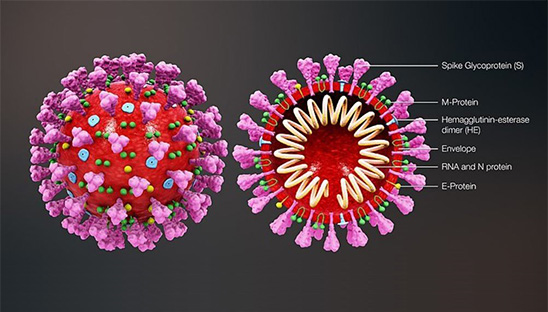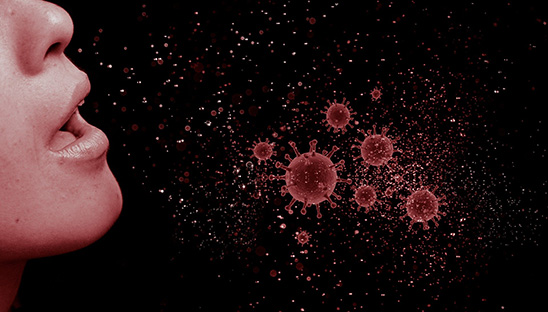What is COVID-19
How it Affects Health | How to Diagnose | Why ImmTekTM | How to Use
Basic Information
Coronavirus disease 2019 (COVID-19) is an infectious respiratory disease caused by a newly discovered coronavirus. The first case of viral pneumonia was detected in Wuhan, China, and reported to World Health Organization (WHO) on December 31, 2019. WHO had earlier given the virus the temporary name of "2019-nCoV”. On February 11, 2020 it was officially renamed “Severe Acute Respiratory Syndrome Coronavirus 2 (SARS-CoV-2)” by the International Committee on Taxonomy of Viruses (ICTV).1
ARS-CoV-2 is positive-sense single-stranded RNA virus with envelope, the virion is approximately 50–200 nanometres in diameter.2 It has four structural proteins, known as the spike (S), envelope (E), membrane (M), and nucleocapsid (N) proteins; the N protein holds the RNA genome, and the S, E, and M proteins together create the viral envelope.3 The gene sequence is similar to Severe Acute Respiratory Syndrome Coronavirus (SARS-CoV) and Middle East Respiratory Syndrome Coronavirus (MERS-CoV) but belong to different species.

Symptoms and Transmission

SARS-CoV-19 mainly infects human respiratory tract epithelial cells and causes coronavirus disease (COVID-19) which WHO has declared a pandemic. People with SARS-CoV-2 infection may be asymptomatic but could still transmit it through respiratory droplets from coughing, sneezing, or talking.4
These droplets can land on objects and surfaces around the people such as tables, doorknobs, and handrails. People may become infected by touching these objects or surfaces, then touching their eyes, nose, or mouth. The incubation period for COVID-19 typically ranges from 2 to 14 days.
Symptoms and signs of COVID-19 are non-specific, however in symptomatic individuals most commonly include: 5.6
• Fever • Dry cough • Fatigue • Shortness of breath
Some infected people may have:
• Headache • Muscle pain • Sore throat Diarrhea • Nasal congestion • Chills or dizziness
• Nausea or vomiting • Sudden loss of taste or smell
Severe patients may progress to:
• Acute Respiratory Distress Syndrome (ARDS) • Septic Shock
• Diffuse Alveolar Damage (DAD) • Death
People with mild symptoms may just need to stay at home, self-quarantine, monitor symptoms, and follow national guidance. However, if you have severe symptoms, such as difficult breathing or pain/pressure in the chest, you should seek medical care. If possible, call your health care provider in advance, so he/she can direct you to the right health facility. The likelihood of severe illness requiring hospitalization correlates closely with advanced age and presence of co-morbidities.5.6
Learn more about COVID-19, please visit :
- World Health Organization
- Centers for Disease Control and Prevention
- Taiwan Centers for Disease Control
Reference :
- A.E. Gorbalenya, S.C. Baker, R.S. Baric. et al. (February 11, 2020) Severe acute respiratory syndrome-related coronavirus: the species and its viruses - a statement of the Coronavirus Study Group. bioRxiv.
- Chen N, Zhou M, Dong X, Qu J, Gong F, Han Y, et al. (15 February 2020). Epidemiological and clinical characteristics of 99 cases of 2019 novel coronavirus pneumonia in Wuhan, China: a descriptive study. The Lancet. 395 (10223): 507–513.
- Wu C, Liu Y, Yang Y, Zhang P, Zhong W, Wang Y, et al. (February 2020). Analysis of therapeutic targets for SARS-CoV-2 and discovery of potential drugs by computational methods. Acta Pharmaceutica Sinica B. doi:10.1016.
- Z. Hu, C. Song, C. Xu. et al. Clinical characteristics of 24 asymptomatic infections with COVID-19 screened among close contacts in Nanjing, China. Sci China Life Sci. 2020; 63(5): 706-711.
- World Health Organization. Q&A on coronaviruses (COVID-19).
https://www.who.int/news-room/q-a-detail/q-a-coronaviruses - Centers for Disease Control and Prevention. Symptoms of Coronavirus.
https://www.cdc.gov/coronavirus/2019-ncov/symptoms-testing/symptoms.html